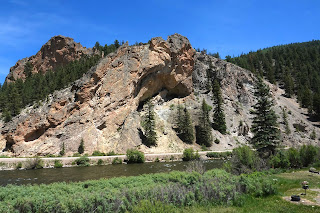In 1984, a Canadian company acquired more than 1200 acres at the summit of South Mountain and began strip mining, using the cyanide drip system to extract minute quantities of gold from crushed ore. This system is commonly used today in Nevada and elsewhere, but there were problems at Summitville. Some of the cyanide, along with heavy metals naturally in the rock there, were carried into the Alamosa River. Local streams had always been naturally acidic, but the rock exposed by strip mining increased the contaminated runoff significantly.
The owners attempted to remediate the damage, but the settlement pond they created suffered leaks. Finally, the company declared bankrupcy and abandoned the site, leaving the U.S. government to deal with it. The site was declared a "superfund" emergency in 1994. Since then, more than $250 million has been spent cleaning up and building a treatment facility and new settlement pond. The EPA sued the company and was awarded $20 million, but the company sued the EPA for using invalid procedures in their suit and recovered $12 million. Easy to calculate how much we taxpayers have contributed to the effort. Now the remediation is being handed off to the state of Colorado for the on-going process at a cost of about $2 million per year.
I drove to Summitville to see firsthand what we had paid for, to see the old buildings and to enjoy a beautiful drive up the mountain. At the 11,500 foot summit, there was still snow on the ground.
Here is the facility built to treat runoff from the strip mine seen at the summit. Next, the pond where treated water is stored until metallic element settle to the bottom. The sludge is removed daily and trucked to a "safe" landfill. There is no projected end for this operation.
























































